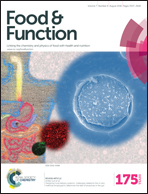Kinetics of bread crumb hydration as related to porous microstructure
Abstract
During oral processing and throughout the digestion process, hydration mechanisms have a key influence on the functional properties of food. This is the case with bread, for which hydration may affect the kinetics of starch hydrolysis as well as taste, aroma and texture perceptions. In this context, the aim of the present study is to understand how crumb porous micro-architecture impacts hydration kinetics. Four types of French baguettes were considered, varying in structure and/or compositions. An experimental set-up was developed for the real-time measurement of water uptake in crumb samples. Mathematical models were then fitted to extract quantitative parameters of use for the description and the understanding of experimental observations. Finally, bread crumb samples were analyzed before and after hydration through X-ray micro-computed tomography for the assessment of crumb micro-architectural properties. Distinct hydration behaviors were observed for the four types of bread. Higher hydration rates and capacities were reported for industrial baguettes (highest porosity) compared to denser semi-industrial, whole wheat and traditional baguettes. However, crumb porosity alone is not sufficient to predict hydration behavior. This study made it possible to point out the importance of capillary action in crumb hydration mechanisms, with a strong role of cells with diameters of 2 mm and below. The high density of these small cells generates high interconnection probabilities that may have an impact both on crumb hydration duration and capacity. As a consequence, accounting for microstructural features resulting from bread formulation may provide useful leverages for the control of functional properties.


 Please wait while we load your content...
Please wait while we load your content...